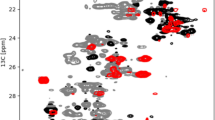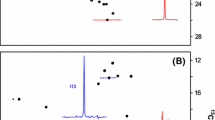Abstract
Stereospecific resonance assignments of the α-protons of glycine are often difficult to obtain by measurements of scalar coupling constants or nuclear Overhauser effects. Here we show that these stereospecific resonance assignments can readily be obtained by cell-free protein synthesis in D2O, as the serine hydroxymethyltransferase, that is naturally present in E. coli cell extracts, selectively replaces the pro-2S proton of glycine by a deuterium. To encourage the conversion by serine hydroxymethyltransferase, we performed the cell-free reaction without the addition of any glycine, exploiting the capability of the enzyme to convert serine to glycine with the help of tetrahydrofolate. 13C-HSQC spectra of ubiquitin produced with 13C/15N-serine showed that about a quarter of the glycine residues derived from serine were stereospecifically deuterated. Pulse sequences are presented that select the signals from the stereospecifically deuterated glycine residues.






Similar content being viewed by others
References
Apponyi MA, Ozawa K, Dixon NE, Otting G (2008) Cell-free protein synthesis for analysis by NMR spectroscopy. In: Kobe B, Guss M, Huber T (eds) Methods in molecular biology 426, structural proteomics: high-throughput methods. Humana Press, Totowa, pp 257–268
Carlomagno T, Peti W, Griesinger G (2000) A new method for the simultaneous measurement of magnitude and sign of 1DCH and 1DHH dipolar couplings in methylene groups. J Biomol NMR 17:99–109
Crowley P, Ubbink M, Otting G (2000) ϕ angle restraints in protein backbones from dipole–dipole cross-correlation between 1HN-15N and 1HN-1Hα vectors. J Am Chem Soc 122:2968–2969
Curley RW Jr, Panigot MJ, Hansen AP, Fesik SW (1994) Stereospecific assignments of glycine in proteins by stereospecific deuteration and 15N labeling. J Biomol NMR 4:335–340
Emsley L, Bodenhausen G (1992) Optimization of shaped selective pulses for NMR using a quaternion description of their overall propagators. J Magn Reson 97:135–148
Etezady-Esfarjani T, Hiller S, Villalba C, Wüthrich K (2007) Cell-free protein synthesis of perdeuterated proteins for NMR studies. J Biomol NMR 39:229–238
Fitzpatrick TB, Malthouse JPG (1996) Proof that serine hydroxymethyltransferase retains its specificity for the pro-2S proton of glycine in the absence of tetrahydrofolate. Biochem Soc Trans 24:132S
Folmer RHA, Hilbers CW, Konings RNH, Nilges M (1997) Floating stereospecific assignment revisited: application to an 18 kDa protein and comparison with J-coupling data. J Biomol NMR 9:245–258
Freeman DM, Hurd R (1997) Decoupling: theory and practice. II. State of the art: in vivo applications of decoupling. NMR Biomed 10:381–393
Gans P, Hamelin O, Sounier R, Ayala I, Durá MA, Amero CD, Noirclerc-Savoye M, Franzetti B, Plevin MJ, Boisbouvier J (2010) Stereospecific isotopic labeling of methyl groups for NMR spectroscopic studies of high-molecular-weight proteins. Angew Chem Int Ed 49:1958–1962
Grzesiek S, Vuister GW, Bax A (1993) A simple and sensitive experiment for measurement of JCC couplings between backbone carbonyl and methyl carbons in isotopically enriched proteins. J Biomol NMR 3:487–493
Güntert P, Braun W, Billeter M, Wüthrich K (1989) Automated stereospecific proton NMR assignments and their impact on the precision of protein structure determinations in solution. J Am Chem Soc 111:3997–4004
Hilty C, Wider G, Fernández C, Wüthrich K (2003) Stereospecific assignments of the isopropyl methyl groups of the membrane protein OmpX in DHPC micelles. J Biomol NMR 27:377–382
Jia X, Ozawa K, Loscha K, Otting G (2009) Glutarate and n-acetyl-l-glutamate buffers for cell-free synthesis of selectively 15N-labelled proteins. J Biomol NMR 44:59–67
John M, Schmitz C, Park AH, Dixon NE, Huber T, Otting G (2007) Sequence- and stereospecific assignment of methyl groups using paramagnetic lanthanides. J Am Chem Soc 129:13749–13757
Kainosho M, Güntert P (2009) SAIL—stereo-array isotope labeling. Quart Rev Biophys 42:247–300
Kainosho M, Torizawa T, Iwashita Y, Terauchi T, Ono AM, Güntert P (2006) Optimal isotope labelling for NMR protein structure determinations. Nature 440:52–57
Kigawa T, Muto Y, Yokoyama S (1995) Cell-free synthesis and amino acid-selective stable-isotope labelling of proteins for NMR analysis. J Biomol NMR 6:129–134
Kontaxis G, Stonehouse J, Laue ED, Keeler J (1994) The sensitivity of experiments which use gradient pulses for coherence-pathway selection. J Magn Reson A111:70–76
Kushlan DM, LeMaster DM (1993) Resolution and sensitivity enhancement of heteronuclear correlation for methylene resonances via 2H enrichment and decoupling. J Biomol NMR 3:701–708
LeMaster DM, LaIuppa JC, Kushlan DM (1994) Differential deuterium isotope shifts and one-bond 1H–13C scalar copulings in the conformational analysis of protein glycine residues. J Biomol NMR 4:863–870
Malthouse JP, Milne JJ, Gariani LS (1991) A comparative study of the kinetics and stereochemistry of the serine hydroxymethyltransferase- and tryptophan synthase-catalysed exchange of the pro-2R and pro-2S protons of glycine. Biochem J 274:807–812
Markley JL, Bax A, Arata Y, Hilbers CW, Kaptein R, Sykes BD, Wright PE, Wüthrich K (1998) Recommendations for the presentation of NMR structures of proteins and nucleic acids. IUPAC-IUBMB-IUPAB inter-union task group on the standardization of data bases of protein and nucleic acid structures determined by NMR spectroscopy. J Biomol NMR 12:1–23
McIntosh LP, Dahlquist FW (1990) Biosynthetic incorporation of 15N and 13C for assignment and interpretation of nuclear-magnetic resonance spectra of proteins. Quart Rev Biophys 23:1–38
Melacini G, Goodman M (1998) Improved method for the stereospecific 1H-NMR assignments in collagen-like triple-helices. Chirality 10:28–34
Morita EH, Shimizu M, Ogasawara T, Endo Y, Tanaka R, Kohno T (2004) A novel way of amino acid-specific assignment in 1H–15 N HSQC spectra with a wheat germ cell-free protein synthesis system. J Biomol NMR 30:37–45
Neri D, Szyperski T, Otting G, Senn H, Wüthrich K (1989) Stereospecific nuclear magnetic resonance assignments of the methyl groups of valine and leucine in the DNA-binding domain of the 434 repressor by biosynthetically directed fractional 13C labeling. Biochemistry 28:7510–7516
Ohki SY, Kainosho M (2008) Stable isotope labeling methods for protein NMR spectroscopy. Prog NMR Spectr 53:208–226
Ozawa K, Headlam MJ, Schaeffer PM, Henderson BR, Dixon NE, Otting G (2004) Optimization of an E. coli system for cell-free synthesis of selectively 15N-labelled proteins for rapid analysis by NMR spectroscopy. Eur J Biochem 271:4084–4093
Plevin MJ, Hamelin O, Boisbouvier J, Gans P (2011) A simple biosynthetic method for stereospecific resonance assignment of prochiral groups in proteins. J Biomol NMR 49:61–67
Sattler M, Schwalbe H, Griesinger C (1992) Stereospecific assignment of leucine methyl groups with 13C in natural abundance or with random 13C labeling. J Am Chem Soc 114:1126–1127
Schirch V, Szebenyi ME (2005) Serine hydroxymethyltransferase revisited. Curr Opin Chem Biol 9:482–487
Senn H, Werner B, Messerle B, Weber C, Traber R, Wüthrich K (1989) Stereospecific assignment of the methyl 1H NMR lines of valine and leucine in polypeptides by nonrandom 13C labelling. FEBS Lett 249:113–118
Shortle D (1994) Assignment of amino-acid type in 1H–15N correlation spectra by labeling with 14N-amino acids. J Magn Reson B 105:88–90
Su XC, Loh CT, Qi R, Otting G (2011) Suppression of isotope scrambling in cell-free protein synthesis by broadband inhibition of PLP enzymes for selective 15N-labelling and production of perdeuterated proteins in H2O. J Biomol NMR 50:35–42
Tang C, Iwahara J, Clore GM (2005) Accurate determination of leucine and valine side-chain conformations using U-[15N/13C/2H]/[1H-(methine/methyl)-Leu/Val] isotope labeling, NOE pattern recognition, and methine Cχ-Hχ/Cβ-Hβ residual dipolar couplings: application to the 34 kDa enzyme IIA(chitobiose). J Biomol NMR 33:105–121
Tonelli M, Singarapu KK, Makino S, Sahu SC, Matsubara Y, Endo Y, Kainosho M, Markley JL (2011) Hydrogen exchange during cell-free incorporation of deuterated amino acids and an approach to its inhibition. J Biomol NMR 51:467–476
Tong KI, Yamamoto M, Tanaka T (2008) A simple method for amino acid selective isotope labeling of recombinant proteins in E. coli. J Biomol NMR 42:59–67
Vijay-Kumar S, Bugg CE, Wilkinson KD, Vierstra RD, Hatfield PM, Cook WJ (1987) Comparison of the three-dimensional structures of human, yeast, and oat ubiquitin. J Mol Biol 262:6396–6399
Wu PSC, Ozawa K, Lim SP, Vasudevan S, Dixon NE (2007) Otting G (2007) Cell-free transcription/translation from PCR amplified DNA for high-throughput NMR studies. Angew Chemie Int Ed 46:3356–3358
Yokoyama J, Matsuda T, Koshiba S, Kigawa T (2010) An economical method for producing stable-isotope labeled proteins by the E. coli cell-free system. J Biomol NMR 48:193–201
Yokoyama J, Takayoshi M, Koshiba S, Tochio N, Kigawa T (2011) A practical method for cell-free protein synthesis to avoid stable isotope scrambling and dilution. Analyt Biochem 411:223–229
Acknowledgments
We thank Professor Masatsune Kainosho for stimulating discussions and a sample of stereospecifically deuterated glycine. Financial support by the Australian Research Council is gratefully acknowledged.
Author information
Authors and Affiliations
Corresponding author
Electronic supplementary material
Below is the link to the electronic supplementary material.
Rights and permissions
About this article
Cite this article
Loscha, K.V., Otting, G. Biosynthetically directed 2H labelling for stereospecific resonance assignments of glycine methylene groups. J Biomol NMR 55, 97–104 (2013). https://doi.org/10.1007/s10858-012-9690-x
Received:
Accepted:
Published:
Issue Date:
DOI: https://doi.org/10.1007/s10858-012-9690-x




